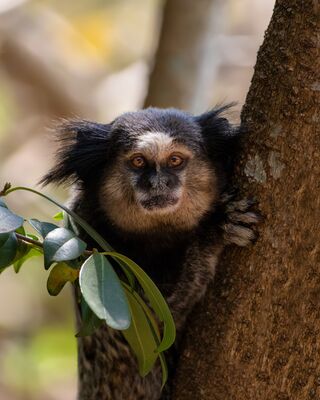Teamwork
Why Do Humans Make War?
What evolution and comparative psychology tell us about war and killing.
Posted December 6, 2022 Reviewed by Abigail Fagan
Key points
- Violence among chimps may result in the loss of an ear or finger, but it rarely ends in death.
- Around a quarter of mammal species show evidence of adult animals killing other adults of the same species.
- Humans are a curious mix of aggressiveness and mistrust typical of our chimp cousins, and cooperation and sharing typical of marmoset monkeys.

To survive, many species kill. Animals that eat other animals account for around two-thirds of all animal species. But for a species to survive, it would not make sense to kill your own kind with abandon. This is a recipe for extinction. Yet for humans, killing one another in great numbers is almost a hallmark of our species. No other species wages deadly, large-scale war the way we do. Why do we kill our kind so frequently, and how does our species yet survive?
Violence vs. Killing
Humans are not exceptional in committing violence against members of our species. Attacks on one's kind are common in the animal world, not least our closest kin, chimpanzees. Troops will defend territory with gusto, and individuals within a troop fight literally tooth and nail for mates.
But though violence among chimps may result in loss of an ear or finger, it rarely ends in death. Killing only happens on rare opportunities, such as might occur when a large patrol of especially agitated males comes upon a lone victim at a territory boundary. Humans, by contrast, take intraspecies violence to an entirely new murderous level through ongoing warfare, in which killing extends over days, months, and years.
Killing Your Own Kind Is Unusual
It may seem surprising that we kill our own so readily, since we lack sharp claws, large horns, long teeth, or great speed. But the likelihood of killing your own is not related to how fearsome a species appears, or what it eats. The animal order in which males are most likely to kill males of their species is the largely plant-eating deer family, which includes camels, goats, sheep and so on. Yet this group’s close kin, the whales, who eat only animals, essentially never kill members of their species. Overall, one study found that around a quarter of mammal species showed evidence of adult animals killing other adults.
From an evolutionary perspective, there are times when killing your own is advantageous. Many mammal species, including humans, are known to practice infanticide, or purposely killing the very young. Infanticide can improve chances of survival for spared offspring, who go on to produce offspring themselves. Leaving aside morality, infanticide can increase chances of the population surviving, especially when disaster strikes.
But what is still puzzling is that human adults kill other human adults in great numbers, and can do so in times of relative plenty.

How We Will Yet Survive (or Not)
I think there are two explanations for why we can get away with killing our own so wantonly. One is that we marry our habit of killing each other to habits of extreme cooperation. As primatologist Sarah Hrdy has observed, human social systems contain a curious mix of characteristics found in other species. On the one hand, our aggressiveness and mistrust of outsiders are fairly typical of our chimp cousins. On the other hand, our cooperation and sharing are typical of more distantly-related monkey species, such as marmosets (who, it must be noted, also practice routine infanticide). While we inflict violence against our kind, we also regularly adopt children from other continents and build extended families of endless diversity in age, sex, and biological relatedness. So part of why we survive is that we compensate for our murderous ways by helping each other to mitigate violence.
But another way of looking at this combination of violence and care is that our capacity for intense cooperation may encourage us to be too good at making war on ourselves. As historian William H. McNeill has observed, “sociality achieves its highest expression in acts of heroism, self-sacrifice and prowess. The bonds of solidarity among warriors are fierce and strong.” It may be too soon to know whether we can continue to be so effective at killing each other and yet survive as a species. Modern humans have only been around for less than 200,000 years, and there is not much physical evidence of humans killing humans before about 15,000 years ago. Perhaps there is a reason other species don't seem to show our combination of cooperative and violent social behaviors. Let's hope it is not our undoing.
Copyright © 2022 Daniel Graham. Unauthorized reproduction of any content on this page is forbidden. For reprint requests, email reprints@internetinyourhead.com.
References
Gómez, J. M., Verdú, M., & González-Megías, A. (2021). Killing conspecific adults in mammals. Proceedings of the Royal Society B, 288(1955), 20211080.
Hrdy, S. B. (2009). Mothers and others: The evolutionary origins of mutual understanding. Harvard University Press.
McNeill, W. H. (2013). The pursuit of power: Technology, armed force, and society since AD 1000. University of Chicago Press.
Wrangham R. W. (2006). Why apes and humans kill. In: Jones M, Fabian JC, editors. Conflict. Cambridge: Cambridge University Press. p 43–62.


